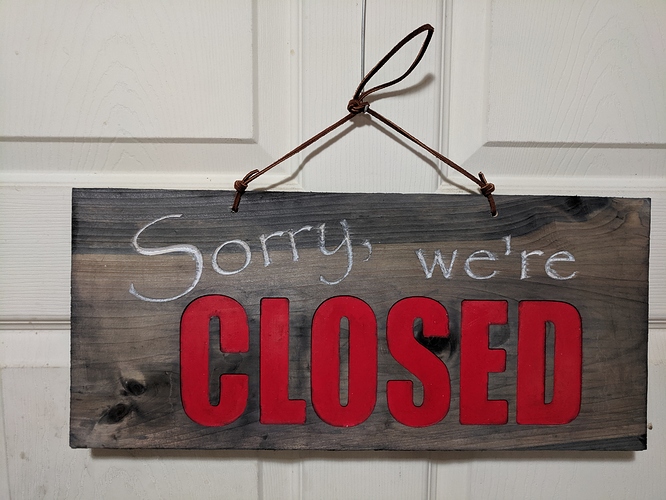Background
So, during a conversation with mb the other day, she mentioned that she needed to look on Amazon for a sign to hang when the restaurant is closed, as some people don’t quite get it. (Hint: If the furniture is all to one wall and someone is mopping and it’s well after the hours posted on the door, well…) I figured that was a good an excuse as any to do a quick sign project on spec.
I knew mb would want a big red-lettered “CLOSED”, and the classic “Sorry, we’re closed” approach seemed like a nice customary design. The restaurant’s sign is a very nice piece of artistic text using Papyrus, so I figured I’d V-carve the “Sorry, we’re” to match and paint that white. I had some nice cypress handy, but it’s very lightly colored, especially when freshly planed, so I would definitely want to do something to enhance the contrast and give it a nice presentation.
As for the typefaces, the scruffy edges of stock Papyrus are not well suited to V-carving and such, so I was going to hand-smooth things. Then a quick search turned up Smooth Papyrus, a drop-in replacement for EF Papyrus (the Windows version). I gladly spent $5 to make my life easier. The “CLOSED” was just Impact, but slightly condensed (compressed in X) to make the fit appealing to me. (The design was all done in Inkscape, then loaded into Carbide Create.)
Making The Sign
I knew I was going for a somewhat rustic feel to the sign, so I figured I’d try out carving through masking tape. I took the planed and very smooth cypress blank and overlaid the entire surface with blue painter’s tape, being careful to leave no gaps. Then I used opposite corners to find and mark the center to set X/Y zeroes.
For the “CLOSED”, I used a 1/4" downcut endmill to make a pocket 2mm deep in one pass with a 2mm stepover and a slow 1000mm/min feed (plunge half that). There was no cypress stringiness to the top edges, and the bottoms of the pockets were smooth. The tape was only slightly frayed. The “Sorry, we’re” was carved with a 90° V-bit, also at 1000mm/min, with slightly more fraying of the tape (but still within acceptable tolerances).
To paint it, I added more masking over the top to cover the “CLOSED” pockets, then spray painted the white lettering. I intentionally laid it on thick and in one coat. After that was sufficiently dry, I carefully peeled the top layer of masking off the “CLOSED” and covered the white text. The red text got a couple thorough coats of red heavy duty enamel spray paint. Once that was set, I removed all layers of masking.
“Aging” The Sign
I wanted the sign to have a distinct greyness to it, and after considering several options, I decided to go with a ferrous sulfate application. (The “steel wool and vinegar” approach is basically the same, just acetate instead of sulfate. It’s much easier and quicker to whip up a batch of ferrous sulfate solution, however, as you just dissolve some ferrous sulfate heptahydrate in some hot water.) Of course, cypress is a low-tannin wood, so it does not react very strongly at all to ferrous sulfate. Conveniently, you can simply add the missing tannins. (The “home” version is to brew up some strong tea, but since I was already picking up some ferrous sulfate, I also ordered powdered mixed tannins.)
I wasn’t concerned with precisely what the final coloration would be, so I just mixed up a strong solution of 10g of ferrous sulfate heptahydrate with 100ml of hot water. In a separate container, I basically just used a nice spoonful (very scientific) of mixed tannins with a something like 100ml or so of hot water. Then I used a paper shop towel to wet down the sign (both faces) with the tannin solution – I didn’t just brush a light dampness on it, but I didn’t immerse the sign or anything. I used a dry paper towel to wick up as much of the tannin solution as I could from the text, but for what I was going for, it wasn’t necessary to be perfect.
After an hour or so, the sign was dry to the touch, so I did the same procedure with the ferrous sulfate solution. (Again, wicking as much out of the white lettering as was convenient.) The endgrain and anywhere that really soaked up both solutions can get quite dark, of course, and the results will vary from wood to wood, piece to piece, and even area to area. The grey coloration began to develop almost immediately, and it progressed somewhat as the ferrous sulfate solution dried.
Note, by the way, that you definitely want to be wearing gloves for all of this. It’s not so much that anything is dangerous, just that skin would take the color remarkably well. 
Once the sign was dry, I used a wet paper towel to clean up most of the residue left on the red lettering. I likely could’ve cleaned it perfectly while the ferrous sulfate solution was still wet, but cleaning it up afterward to leave the bits of “dirty” edges and such was an intentional design choice. The red lettering did clean up remarkably well, and with a small amount of effort, I probably could have made it look brand new.
The Results
So, here you go. Total active project time was under an hour (with plenty of standby time that I used to get a total of 50 bike-miles ridden during the waiting). The results are generally in line with what I was looking for from the project, and the sign should blend in well enough with the style and decor of the restaurant, assuming mb and the owner like it.
